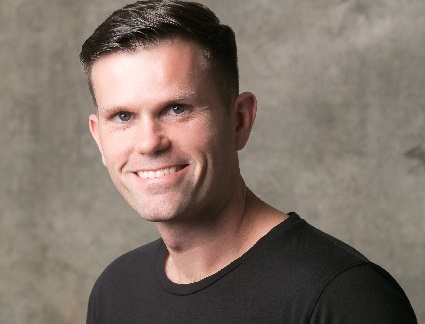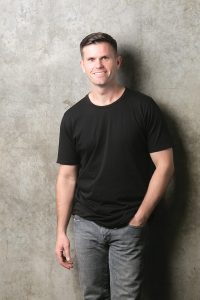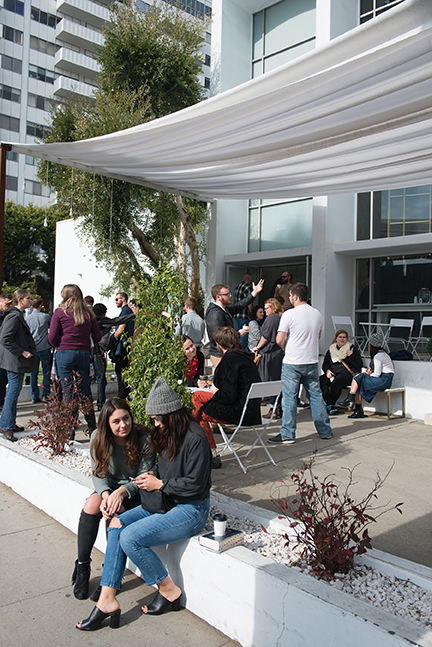
 Ask most people, and they’ll say the appeal of MOSAIC — a world-regarded Millennial-revered church in the heart of Hollywood — is, in some ways, intangible. Executive Pastor Lawrence Fudge would agree … to a point.
Ask most people, and they’ll say the appeal of MOSAIC — a world-regarded Millennial-revered church in the heart of Hollywood — is, in some ways, intangible. Executive Pastor Lawrence Fudge would agree … to a point.
The rest, he says, is equal parts creativity, imagination, experimentation and community-building. MOSAIC is a culture of welcome (no matter where you are on your faith journey).
It’s a place where new, young church leaders are very purposefully trained up, and where current leaders have a constant eye trained on the faith horizon — and beyond.
And then there’s technology. Mobile technology, to be specific.
When did you join the staff at MOSAIC, and what led you to this church?
I moved to Los Angeles in 2005. My wife and I were newly married, and we wanted to live somewhere new for a while. We began to attend and serve at MOSAIC. One year in, I heard a message about sacrifice — sacrifice of money, time and more. Go and spend as much time around people you want to become like. I really took that to heart.
I interned at MOSAIC for two years, pretty much full-time. After that, I continued to volunteer — I didn’t go and get a job elsewhere. In late 2009, I was invited to come on staff and started in January 2010.
I didn’t come from another church; I was a volunteer leader and was invited to take on more leadership and responsibility at the church. That’s kind of our model for hiring, in general.
MOSAIC has a well-established reputation as innovative and Millennial-focused. Is this an accurate depiction?
It’s accurate in one sense, but it’s a little overstated in another — if people think we’re exclusively focused on Millennials, I mean.
We reflect our community. Hollywood is very young, and the church demographic really matches Hollywood’s demographic. So, we are young; we do reach young people. About 70 percent of our weekly attenders are between 20 and 34 and single, so they definitely fall into that category.
Our community is very transient. People come in and out of the city often. They pursue a dream; maybe they make it, and maybe they don’t. So, the turnover is really high.
Part of it is that we feel a responsibility to train up young leaders. Pastor Erwin [McManus] talks a lot about how much of our responsibility is to be like a teaching hospital — to train up people who will carry that on in the future. Because of this, we have leaders at MOSAIC who are Millennials.
“I think what mobile giving has done is to help us access people quicker. They can give that first gift easily, which is a huge breakthrough moment, spiritually.”
Though some of the appeal of MOSAIC for Millennials is likely intangible, let’s talk about the elements that can be pinpointed. In what ways has the church been able to reach this often-elusive demographic?
I haven’t found [Millennials to be elusive], to be honest. Some of the things that have been real values at MOSAIC for years — creativity, imagination and experimentation — really resonate with our people. They have a hard time with standardization or feeling like they’re cogs in a wheel.
 Also, one of the things we value so much is the ability to provide a place where everybody can belong before they believe. Millennials may not carry a bound-and-set beliefs system; even so, they can come to church and know that they belong, and that they have a family here while they’re still in the process of figuring out where they are in their own personal beliefs. I think that creates a safe space for them.
Also, one of the things we value so much is the ability to provide a place where everybody can belong before they believe. Millennials may not carry a bound-and-set beliefs system; even so, they can come to church and know that they belong, and that they have a family here while they’re still in the process of figuring out where they are in their own personal beliefs. I think that creates a safe space for them.
Also, when they look around, they see other people who’ve grown and are leaders in the church, and who are peer-aged — that inspires them. It makes them feel like, There’s not just room for me here; I actually can become somebody here. I can grow here. There’s no glass ceiling about who I can become if I have the right character, the right giftings.
How we communicate has also been instrumental. Pastor Erwin, of course, has a really unique gifting in how he communicates, and he helps to shape us. I think that has influenced how all of us communicate and share the gospel.
There’s also nuanced things. A couple years ago, we were looking at how we communicated through social media, for example. A lot of our communications are done via Instagram or Twitter. The younger you are, the more likely you are to get your information through those means. I didn’t get what some of the younger people on our team were creating in that sense. I didn’t totally understand it. But, the response has been overwhelming!
The thing is, I’m 35; I’m not that far out of the Millennial category. But, these people are 25 and maybe younger. They know how their peers are communicating and are using these tools better than I could.
And you know, technology is just that: a tool. It changes. Tools change. When one tool is no longer useful, you throw it away and pick up another tool.
If you look at our website right now, it’s super simple. There’s not a lot of info on it. We don’t put much on the calendar. It’s simple. It’s clean. It’s clear. It’s aesthetically really nice. But, it’s not info-heavy.
Our traffic on our social media is very, very high. Our traffic to our website is almost entirely mobile. So, people aren’t looking for tons of data and info on their phones when they go to a website; they’re usually looking for something quick — when, where, those types of things.
What are some tech tools you use to be more progressive in giving and reaching younger people at MOSAIC?
Last spring, we implemented Pushpay, and the eChurch app was implemented a little later. The app — the custom app we use now — was actually part of a conversation I had with the company early on. I was trying to solve a problem: How do we move people from guest to giver quicker? I felt like the on-ramp took too long.
I really liked how they approached giving. I liked what they were offering and how their systems worked. And I wanted us to have our own mobile app at MOSAIC — a place that would host content (our content) but that would also enable giving.
We discussed this, and Pushpay agreed that MOSAIC would be a sort of “beta test” for the custom church app that they offer now, eChurch.
People are used to paying for things fast and easily on their mobile devices. I felt like giving should be able to match that. If we value giving to the church like we say we do, we have to make it simple for people.
For instance, we have a really large podcast following at MOSAIC. With the app, I just wanted a single place where we could put all that content, and incorporate giving into it. Pushpay’s technology has allowed us to centralize all these things into one place on a mobile platform. We envisioned the person who’s at the gym, on the treadmill, listening to a MOSAIC podcast, and then — while they’re there doing that — they also want to give to MOSAIC. How do we make that accessible?
Pushpay heard that, and they took on that project.
 To be an early adopter of any technology takes real confidence. What would you say to a church leader who’s hesitant?
To be an early adopter of any technology takes real confidence. What would you say to a church leader who’s hesitant?
To me, the real risk is that you don’t adapt. That you stay the same and the world changes around you, and now you’re no longer moving people to give at all. Culture has already shifted; how people manage their personal finances has changed. If we don’t also adapt, the Church is going to be left farther and farther behind.
Pastors struggle. We’re simultaneously thinking about and caring for the people we have, thinking about and trying to reach the people we don’t have — and they’re different people!
The people you’ve had for a long time, if they’re doing the things you call them to do — giving being one of those things — they’re already doing what you’ve asked. The people you haven’t reached yet don’t understand that value. And even when they get there, they probably aren’t going to do it the same way as the person who’s done it for years. So, a value I’ve been taught [at MOSAIC] is, How do you make the decisions for those you haven’t yet reached? That’s the future.
We’re a little bit heightened [at MOSAIC] in the sense that the people we reach are largely of a transient nature. People come in to Los Angeles and Hollywood and move out just as often. With that frequency, we’ve had to adapt quicker because there’s really no guarantee that our people will be with us five or 10 years from now. It’s just not our reality.
Today, what percent of gifts to MOSAIC are given digitally versus traditionally?
About 81 percent of gifts are given digitally through the technology platform we have with Pushpay and their eChurch app. We were at about 60 percent when we made the shift to Pushpay a year ago, and that was when we were using tools I wasn’t as happy with. So, I knew the future of giving at the church would be almost entirely digital. Pretty much everybody under 40 is giving through some sort of electronic method.
I will say, though, that among the 81 percent of people who give digitally, recurring gifts are a little tougher to gauge. Los Angeles is full of people who function like independent contractors. Not a lot of people are salaried employees.
If you work in entertainment, for example, it can be feast or famine. If a person is working on a project, they might make a ton of money, but then there might be a period of time before they work again.
In what ways does Pushpay’s mobile giving enhance the worship experience — and ministry — at MOSAIC?
Giving absolutely is part of worship, and we’ve continued to adapt how we approach that time in our gatherings. We’ve gotten stronger in how we ask, and how we’ve elevated the value — not just of being generous, but of being generous to the mission of the church. There should be no more important place in the world to give to than the church — specifically, to the church you’re joining in mission with.
We’re talking a lot about Millennials today, but I think it’s broader than that; many people, generally, don’t have a value for giving. While Millennials are often generous through socially conscience businesses or nonprofits, many don’t have a connection to a tithe. It may not have been ingrained in them in childhood, so you can’t assume their generosity.
I think what mobile giving has done is to help us access people quicker. They can give that first gift easily, which is a huge breakthrough moment, spiritually.
While I don’t think our growth in giving is exclusively because of mobile giving, I believe we now have the tools to help us grow our church into being more generous.
Mobile giving data can also help our team identify areas of ministry opportunity. We can see trends — changes in attendance or giving, for example. When giving stops, it’s a sign of something. It could be a sign that they’re in financial difficulty. It could also be a sign that there’s something spiritually happening. It could indicate home struggles, or they could be struggling with the church in some capacity. You never know.
In any case, it does communicate something, and it does allow you an opportunity to reach out and see how things are going.
It’s likely that MOSAIC will continue to set an example for what’s needed to reach younger generations. How do you envision the church looking different in 10 years?
That’s a big question. I think we’ve begun to see some of it already — a move away from more traditional methods of communicating, whether it’s printed materials or a website visited on a desktop. Fewer and fewer people will access their information that way. MOSAIC is kind of there now, because it’s just the nature of who we reach. I think we’ll continue to go in that direction.
We’re already an on-demand culture. People want to access what they want, now. That’s where mobile devices come in.
For example, in the month of February, we run a modified schedule at MOSAIC, and mobile devices are a huge tool for us. It’s a crazy month on Hollywood Boulevard — Superbowl Sunday, the LA Marathon and the Academy Awards. During a lot of these events, you can’t really access to our building.
We’ve learned that communicating schedule changes through email will miss the majority of people. But, if we encourage — as we have — the whole church to have the mobile app on their phones, we just send push notifications. It’s far, far more effective.
Emails get filtered; they go into the junk folder; they become white noise. We all have far too many emails. We put far more stock into the power of mobile devices.
And, on the back end, we can get all kinds of fascinating, important information about who our people are, because we “see” them. We see their activity. We see where in the country they are. When people download an app, and you ask where they live, you can see: Wow, there’s this unique contingent of people in this city who follow us and know what’s happening at our church. Are there opportunities to develop community around that? I think the trends driven by that type of data are going to continue at MOSAIC.
You know, 20 years ago — when MOSAIC became a multisite church and was meeting at a nightclub at night — there wasn’t a model for that. But, Pastor Erwin was able to see the vision and potential.
He has really called us to be in the “R&D” [research and development] arm of the Church. We may not master everything, but we’re going to try it out. If we experiment and it works, it might open the doors for other churches, as well.
At MOSAIC, we talk a lot with churches that seem very different than us. We’re not experts in all of this. But maybe — if making certain changes seems risky to one of those churches — any success we see here will give others the confidence to make those changes, too.
— Reporting by RaeAnn Slaybaugh
QUICK FACTS ABOUT MOSAIC
Lead Pastor & Founder: Erwin McManus
Location of main campus: Hollywood, CA — on the corner of Hollywood Boulevard and La Brea, one block from the Hollywood Walk of Fame.
Number of staff (full- and part-time): 20 full-time, 5 part-time
Combined weekly attendance: 3,500


